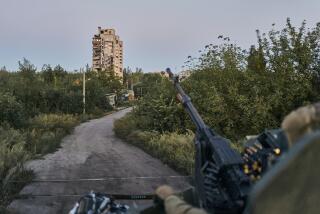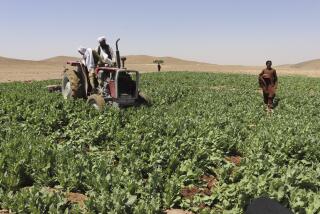New Allied Sweep Targets Al Qaeda
- Share via
KABUL, Afghanistan — In a renewed offensive to sweep Taliban and Al Qaeda holdouts from their mountain lairs, British Royal Marines backed by U.S. Special Forces and other troops scoured the caves and crevices of eastern Afghanistan on Thursday.
The British-led offensive by about 1,000 fighters, code-named Operation Snipe, appears to be employing a pincer movement, with troops closing in on a network of caves and hide-outs from both sides of the rugged Afghan-Pakistani border.
U.S.-led coalition forces have already made numerous attempts to kill or capture Osama bin Laden’s loyalists hiding in the hostile eastern territory. But each time, some fighters have managed to escape--and some of them are thought to be across the poorly guarded border, which is delineated by soaring peaks and laced with circuitous tunnels.
U.S. and Pakistani authorities have confirmed a troop buildup on the Pakistani side, where local tribes still strongly support Afghanistan’s deposed Taliban regime and its religious extremism.
At Bagram air base, an hour’s drive north of the Afghan capital, Kabul, British Brig. Roger Lane declined to specify the area targeted by Operation Snipe. Royal Marines spokesman Lt. Col. Paul Harradine denied that it was the Khowst-Gardez area where coalition troops have been seen in increasing numbers this week.
Lane said the target of the offensive is “one of the few remaining areas that has never before been investigated by coalition ground forces, and we have good reason to believe that it is or has been a key base for the Al Qaeda terrorist network.”
Harradine said U.S. Apache attack helicopters and A-10 Warthog jets were on hand to provide air cover.
U.S. forces on both sides of the border have come under repeated attack in the last few days. As many as four rockets were fired Thursday at the Khowst airport, where U.S. troops are based. It was the second attack on the site in two weeks. U.S. positions in the Waziristan region of Pakistan, just across the border, were hit with rocket fire Wednesday.
The attacks have not resulted in casualties or serious damage, but they do illustrate the hazards that coalition forces face as they confront a determined enemy on its own turf.
Coalition forces patrolling eastern Afghanistan have encountered Taliban and Al Qaeda stragglers this week, killing four in two exchanges of fire at close range Monday and Tuesday. On Thursday, Australian forces killed another Al Qaeda suspect whom they encountered on patrol, said a military spokesman in Canberra, the Australian capital.
Most of the Operation Snipe force was deployed Monday, but none of the troops assigned to the mission has yet come into contact with enemy forces, Harradine said.
The British spokesman said there was no credible intelligence that Bin Laden was in the area, despite claims by some local fighters that he is.
British troops make up about half of the force, with about 100 U.S. Special Forces soldiers providing support along with Canadians, Australians and several hundred Afghan allies.
Lane declined to say how many Taliban and Al Qaeda fighters are believed to be holed up in the area, where mountains tower as high as 13,000 feet. The success of the campaign “will not be measured solely in a count of the number of dead terrorists,” he said, but he did not specify what other yardsticks would be used.
British officers said earlier this week that any fighters they capture will be remanded to Afghan custody under the Geneva Conventions’ rules for treatment of prisoners of war.
Those captured by U.S. forces so far have been labeled “illegal combatants” and are being denied the rights and conditions normally granted to POWs--a sore point between Washington and some European allies.
The area targeted by Operation Snipe appears to be near where Operation Anaconda took place two months ago. U.S. military officials say that campaign, in the Shahi Kot valley southeast of Gardez, killed hundreds of Al Qaeda or Taliban fighters. Eight Americans also died in the fighting.
In December, U.S.-led coalition forces pounded the Tora Bora mountain region near Jalalabad for weeks in pursuit of Bin Laden and his fighters. Many were reported killed, but the main targets of the campaign apparently slipped over the border into Pakistan.
More to Read
Sign up for Essential California
The most important California stories and recommendations in your inbox every morning.
You may occasionally receive promotional content from the Los Angeles Times.










